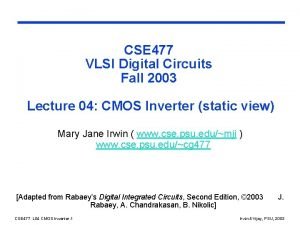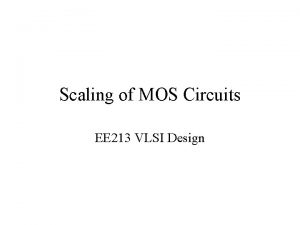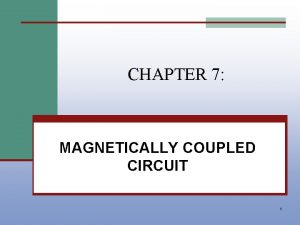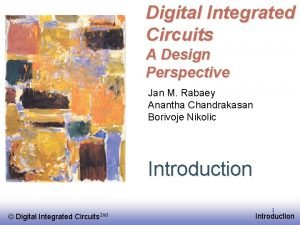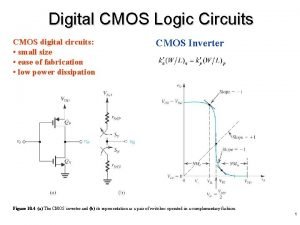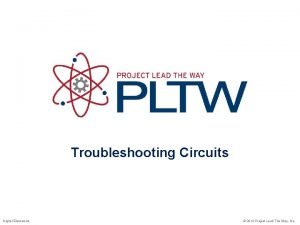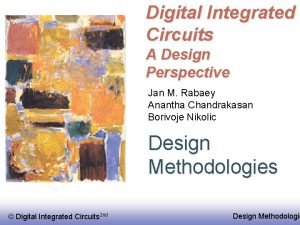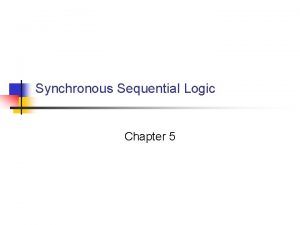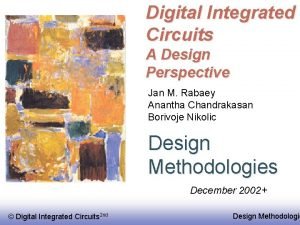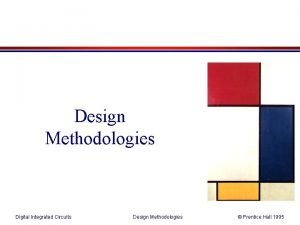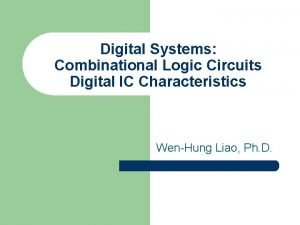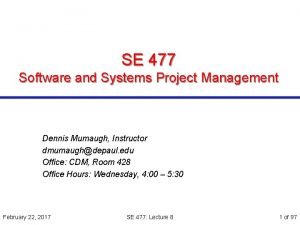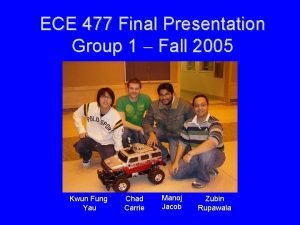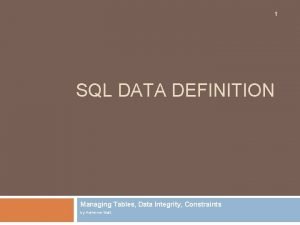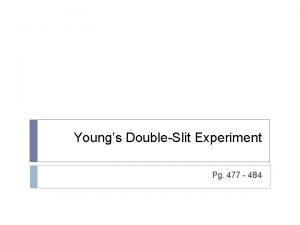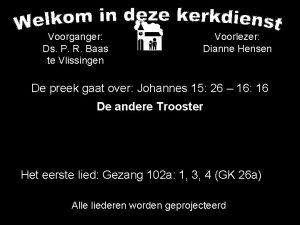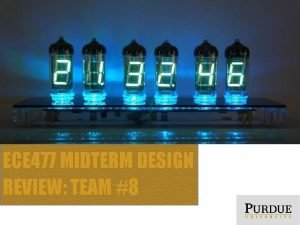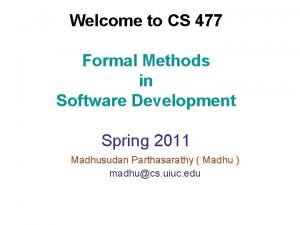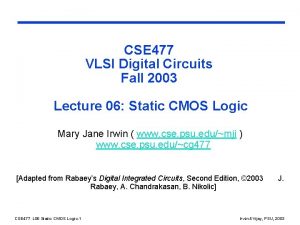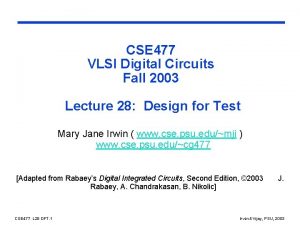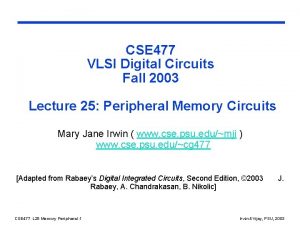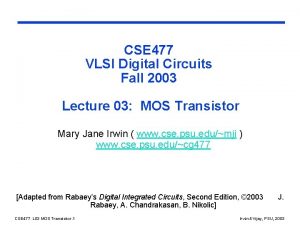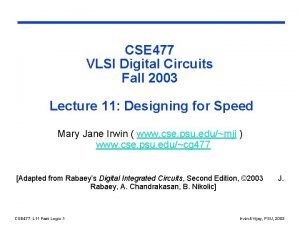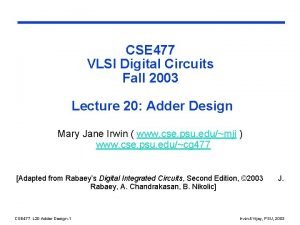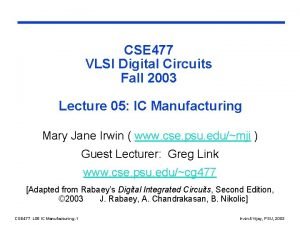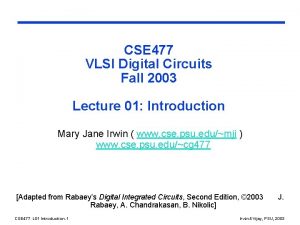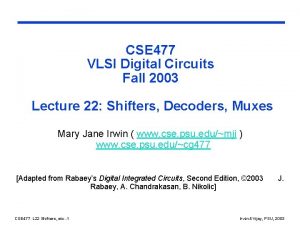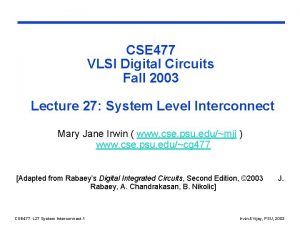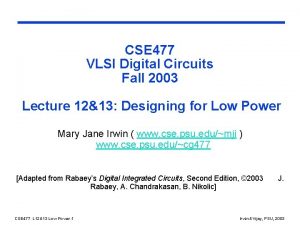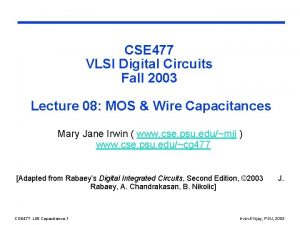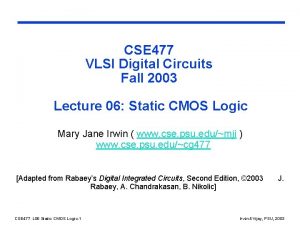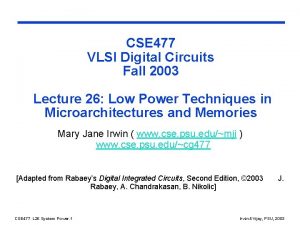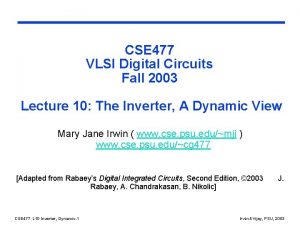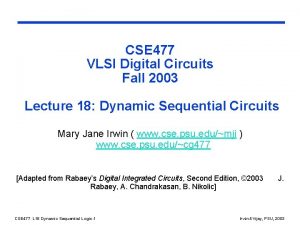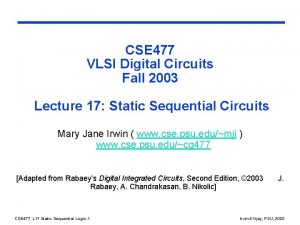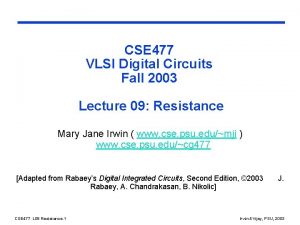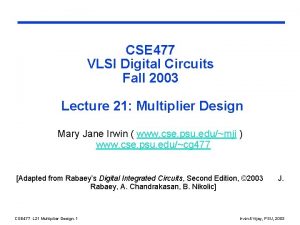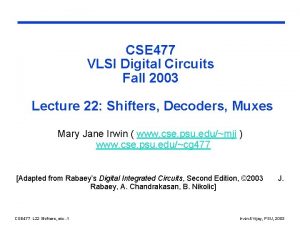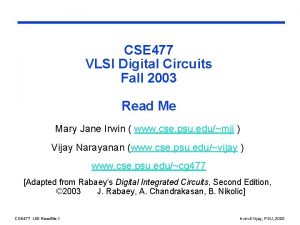CSE 477 VLSI Digital Circuits Fall 2003 Lecture

























- Slides: 25

CSE 477 VLSI Digital Circuits Fall 2003 Lecture 23: Semiconductor Memories Mary Jane Irwin ( www. cse. psu. edu/~mji ) www. cse. psu. edu/~cg 477 [Adapted from Rabaey’s Digital Integrated Circuits, Second Edition, © 2003 Rabaey, A. Chandrakasan, B. Nikolic] CSE 477 L 23 Memories. 1 J. Irwin&Vijay, PSU, 2003

Review: Basic Building Blocks q Datapath l Execution units - Adder, multiplier, divider, shifter, etc. q l Register file and pipeline registers l Multiplexers, decoders Control l q Interconnect l q Finite state machines (PLA, ROM, random logic) Switches, arbiters, buses Memory l Caches (SRAMs), TLBs, DRAMs, buffers CSE 477 L 23 Memories. 2 Irwin&Vijay, PSU, 2003

Memory Definitions q Size – Kbytes, Mbytes, Gbytes, Tbytes q Speed l l l Read Access – delay between read request and the data available Write Access – delay between write request and the writing of the data into the memory (Read or Write) Cycle - minimum time required between successive reads or writes Read Cycle Read Access Write Cycle Write Setup Write Access Data Valid CSE 477 L 23 Memories. 3 Data Written Irwin&Vijay, PSU, 2003

A Typical Memory Hierarchy q By taking advantage of the principle of locality, we can l l present the user with as much memory as is available in the cheapest technology at the speed offered by the fastest technology. On-Chip Components Control e. DRAM Instr Data Cache . 1’s 10’s 100’s Size (bytes): 100’s K’s 10 K’s M’s Cost: CSE 477 L 23 Memories. 4 ITLB DTLB Speed (ns): Datapath Reg. File Second Level Cache (SRAM) highest Main Memory (DRAM) Secondary Memory (Disk) 1, 000’s T’s lowest Irwin&Vijay, PSU, 2003

More Memory Definitions q Function – functionality, nature of the storage mechanism l q static and dynamic; volatile and nonvolatile (NV); read only (ROM) Access pattern – random, serial, content addressable Read Write Memories (RWM) Random Access Non-Random Access SRAM (cache, register file) FIFO, LIFO DRAM (main memory) Shift Register NVRWM ROM EPROM Mask-prog. ROM EEPROM FLASH CAM Electricallyprog. PROM q Input-output architecture – number of data input and output ports (multiported memories) q Application – embedded, secondary, tertiary CSE 477 L 23 Memories. 5 Irwin&Vijay, PSU, 2003

Random Access Read Write Memories (WRMs) q SRAM – Static Random Access Memory l data is stored as long as supply is applied large cells (6 fets/cell) – so fewer bits/chip fast – so used where speed is important (e. g. , caches) l differential outputs (output BL and !BL) l use sense amps for performance l compatible with CMOS technology l l q DRAM - Dynamic Random Access Memory l l l periodic refresh required (every 1 to 4 ms) to compensate for the charge loss caused by leakage small cells (1 to 3 fets/cell) – so more bits/chip slower – so used for main memories single ended output (output BL only) need sense amps for correct operation not typically compatible with CMOS technology CSE 477 L 23 Memories. 6 Irwin&Vijay, PSU, 2003

Evolution in DRAM Chip Capacity human memory human DNA 4 X growth every 3 years! 0. 07 m 0. 13 m 0. 18 -0. 25 m book 0. 35 -0. 4 m 0. 5 -0. 6 m 0. 7 -0. 8 m 1. 0 -1. 2 m encyclopedia 2 hrs CD audio 30 sec HDTV 1. 6 -2. 4 m page CSE 477 L 23 Memories. 7 Irwin&Vijay, PSU, 2003

6 -transistor SRAM Storage Cell WL M 2 M 5 q M 6 !Q M 1 !BL M 4 Q M 3 BL Will cover how the cell works in detail in the next lecture CSE 477 L 23 Memories. 8 Irwin&Vijay, PSU, 2003

1 D Memory Architecture M bits S 0 Word 0 S 1 Word 1 S 2 Word 2 A 0 S 2 Word 2 A 1 S 3 Storage Cell Ak-1 SN-2 Word N-2 SN-1 Word N-1 Input/Output N words N select signals CSE 477 L 23 Memories. 9 Decoder N words M bits SN-2 SN-1 Storage Cell Word N-2 Word N-1 Input/Output Decoder reduces # of inputs K = log 2 N Irwin&Vijay, PSU, 2003

2 D Memory Architecture bit line (BL) AL AL+1 AK-1 Row Decoder word line (WL) Column Address (least significant bits) Row Address 2 K-L A 0 A 1 AL-1 storage (RAM) cell M 2 L Column Decoder Sense Amplifiers selects appropriate word from memory row amplifies bit line swing Read/Write Circuits Input/Output (M bits) CSE 477 L 23 Memories. 10 Irwin&Vijay, PSU, 2003

Block Column Addr Row Addr 3 D (or Banked) Memory Architecture A 1 A 0 Input/Output (M bits) Advantages: 1. Shorter word and bit lines so faster access 2. Block addr activates only 1 block saving power CSE 477 L 23 Memories. 11 Irwin&Vijay, PSU, 2003

2 D 4 x 4 SRAM Memory Bank A 1 A 2 Row Decoder read precharge enable bit line precharge WL[0] !BL BL WL[1] WL[2] WL[3] 2 bit words clocking and control A 0 Column Decoder sense amplifiers BLi CSE 477 L 23 Memories. 12 BLi+1 write circuitry Irwin&Vijay, PSU, 2003

Quartering Gives Shorter WLs and BLs Precharge Circuit Write Circuitry Sense Amps Ai-1 … A 0 Column Decoder AN-1 … Ai Read Precharge CSE 477 L 23 Memories. 13 Row Decoder data Precharge Circuit Write Circuitry Sense Amps Column Decoder Read Precharge Irwin&Vijay, PSU, 2003

Decreasing Word Line Delay q Drive the word line from both sides driver WL polysilicon word line driver metal word line q Use a metal bypass WL polysilicon word line metal bypass q Use silicides CSE 477 L 23 Memories. 14 Irwin&Vijay, PSU, 2003

Decreasing Bit Line Delay (and Energy) q Reduce the bit line voltage swing l need sense amp for each column to sense/restore signal q Isolate sense amps from bit lines after sensing (to prevent the sense amps from changing the bit line voltage further) - bit line isolation q Isolate memory cells from the bit lines after sensing (to prevent the memory cells from changing the bit line voltage further) - pulsed word line l generation of word line pulses very critical - too short - sense amp operation may fail - too long - power efficiency degraded (because bit line swing size depends on duration of the word line pulse) l use feedback signal from bit lines CSE 477 L 23 Memories. 15 Irwin&Vijay, PSU, 2003

Bit Line Isolation BL !BL V = 0. 1 Vdd isolate Read sense amplifier sense V = Vdd sense amplifier outputs CSE 477 L 23 Memories. 16 Irwin&Vijay, PSU, 2003

Pulsed Word Line From Row Decoder !BL WL BL Dummy column cells tied to a fixed value (0) Done (1 0) 10% populated so capacitance is 10% of a regular column Read Done WL BL Dummy BL CSE 477 L 23 Memories. 17 q V = 0. 1 Vdd Dummy BL has reached full swing and triggers Done ( 0) when regular BLs reach 10% swing V = Vdd Irwin&Vijay, PSU, 2003

Read Only Memories (ROMs) q A memory that can only be read and never altered l l Programs for fixed applications that once developed and debugged, never need to be changed, only read Fixing the contents at manufacturing time leads to small and fast implementations. BL = 1 WL BL = 0 WL CSE 477 L 23 Memories. 18 BL = 0 WL Irwin&Vijay, PSU, 2003

Precharged MOS NOR ROM VDD 0 1 precharge 1 A 1 0 A 2 Row Decoder enable WL(0) 0 WL(1) 0 1 GND on on WL(2) 0 GND WL(3) 0 BL(0) 1 0 CSE 477 L 23 Memories. 22 BL(1) 1 1 BL(2) 1 1 BL(3) 1 0 Irwin&Vijay, PSU, 2003

MOS NOR ROM Layout 1 q Memory is programmed by adding transistors where needed (ACTIVE mask – early in the fab process) cell size of 9. 5 x 7 WL(0) GND WL(1) metal 1 on top of diffusion WL(2) GND WL(3) CSE 477 L 23 Memories. 23 Irwin&Vijay, PSU, 2003

MOS NOR ROM Layout 2 q WL(0) GND Memory is programmed by adding contacts where needed (CONTACT mask – one of the last processing steps) l WL(1) the presence of a metal contact creates a 0 -cell size of 11 x 7 WL(2) GND WL(3) CSE 477 L 23 Memories. 24 Irwin&Vijay, PSU, 2003

Transient Model for 512 x 512 NOR ROM precharge poly metal 1 rword BL Cbit WL cword Word line parasitics (distributed RC model) Resistance/cell: 17. 5 Wire capacitance/cell: 0. 049 f. F Gate capacitance/cell: 0. 75 f. F Bit line parasitics (lumped C model) Resistance/cell: 0. 275 (which is negligible) Wire capacitance/cell: 0. 09 f. F Drain capacitance/cell: 0. 8 f. F CSE 477 L 23 Memories. 25 Irwin&Vijay, PSU, 2003

Propagation Delay of 512 x 512 NOR ROM q Word line delay l q Delay of a distributed rc-line containing M cells tword = 0. 38(rword x cword) M 2 = 0. 38 (17. 5 x (0. 049 + 0. 75) f. F) 5122 = 1. 4 nsec Bit line delay l Assuming (0. 5/0. 25) pull-down and (1. 3125/0. 25) pull-up with reduced swing bit lines (2. 5 V to 1. 5 V) Cbit = 512 x (0. 8 + 0. 09) f. F = 0. 46 p. F t. HL = 0. 69 (13 k /2 || 31 k /5. 25) 0. 46 p. F = 0. 98 nsec (and CSE 477 L 23 Memories. 26 t. LH = 0. 69 (31 k /5. 25) 0. 46 p. F = 1. 87 nsec) Irwin&Vijay, PSU, 2003

Nonvolatile Read-Write Memories (NVRWM) q UV (ultraviolet light exposure), FN (Fowler-Nordheim tunneling), Hot e (avalanche hot-electron-injection); VDD = 3. 3 or 5 V; VPP = 12 or 12. 5 V MASK ROM EPROM # Cell Mechanism Trans Area Erase Write /Cell 1 T 0. 35 -5 Power Supply Write VDD Program/ Erase Cycles 0 Read 1 T 1 UV Hot e VPP VDD ~100 EEPROM 2 T 3 -5 FN FN VPP (int) VDD 104 -105 FLASH 1 T 1 -2 FN Hot e VPP VDD 104 -105 FN FN VPP (int) VDD 104 -105 CSE 477 L 23 Memories. 27 Irwin&Vijay, PSU, 2003

Next Lecture and Reminders q Next lecture l SRAM, DRAM, and CAM cores - Reading assignment – Rabaey, et al, 12. 2. 3 -12. 2. 4 q Reminders l HW#5 will (optional) due December 2 nd l Project final reports due December 4 th l Final grading negotiations/correction (except for the final exam) must be concluded by December 10 th Final exam scheduled l - Tuesday, December 16 th from 10: 10 to noon in 118 and 113 Thomas CSE 477 L 23 Memories. 28 Irwin&Vijay, PSU, 2003
 Cse477
Cse477 Scaling factor in vlsi
Scaling factor in vlsi What is a parallel circuit in physics
What is a parallel circuit in physics Cmos vlsi design lecture notes
Cmos vlsi design lecture notes Magnetically coupled circuits lecture notes
Magnetically coupled circuits lecture notes Cast of spring, summer, fall, winter... and spring
Cast of spring, summer, fall, winter... and spring 01:640:244 lecture notes - lecture 15: plat, idah, farad
01:640:244 lecture notes - lecture 15: plat, idah, farad Digital integrated circuits: a design perspective
Digital integrated circuits: a design perspective Digital integrated circuits: a design perspective
Digital integrated circuits: a design perspective Digital circuits
Digital circuits Troubleshooting digital circuits
Troubleshooting digital circuits Digital integrated circuits a design perspective
Digital integrated circuits a design perspective Digital circuits
Digital circuits Digital integrated circuits
Digital integrated circuits Signal circuit
Signal circuit Digital ic characteristics
Digital ic characteristics Sw 477
Sw 477 Diketahui log 2 = 0
Diketahui log 2 = 0 Ece 477
Ece 477 Sepura *477
Sepura *477 Biba n 477 ddl
Biba n 477 ddl Experiment 484
Experiment 484 Liedboek 477
Liedboek 477 Ece 477
Ece 477 Cs 477 uiuc
Cs 477 uiuc Opwekking 477
Opwekking 477
